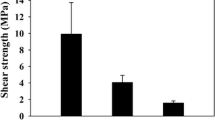Abstract
This paper deals with the improvement of the TTV values (Total Thickness Variation) of 300 mm silicon wafers thinned down at 100 μm using the ZoneBond® (ZoneBond® is registred by Brewer Science Inc.) technology. We have demonstrated that the thin film TTV of the film was mainly driven by the bonding process and was very tolerant towards the coating step. It was also shown that, within the experiment precision, the TTV value was not changed by the grinding thinning process. 8 µm was the best TTV value obtained after the optimization of the bonding parameters.












Similar content being viewed by others
Notes
Microprof ® is registred by FRT.
References
Akiyama R, Nakajima S et al (2009) Method of manufacturing wafer laminated body, device of manufacturing wafer laminated body, wafer laminated body, method of peeling support body, and method of manufacturing wafer. US Patent, PCT/US2009/055142
Bourbina ML, Bremmer JN et al (2012) Wafer bonding system and method for bonding and debonding thereof, US Patent, PCT/US2012/026448
Buisson T, Potoms G et al (2011) Integration challenges of cu pillars with extreme wafer thinning for 3D stacking and packaging. EPTC Conf 13:25–28
Charbonnier J, Cheramy S et al (2009) Integration of a temporary carrier in a TSV process flow, electronic components and technology conference 2009. ECTC 59:865–871
Chou KA, Najafi K (2001) 3D MEMS Fabrication using low temperature wafer bonding with benzocyclobutene (BCB). In: Proceedings of Transducers, Munich, pp 1570–1573
Cuminatto C, Braccini M et al (2013) Mechanical resistance of patterned BCB bonded joints for MEMS packaging. Microelectron Eng 111:39–44
Ferrandon C, Jouve A et al (2013) Innovative wafer-level encapsulation and underfill material for silicon interposer application. Electron Compon Technol Conf (ECTC) 63:761–767
Flain T, McCutcheron J (2009) Method for reversibly mounting a device to a carrier substrate. UC Patent, US20098/0218560
Hideto K, Michihiro S et al. (2012) Wafer processing laminate, wafer processing member, temporary bonding arrangement, and thin wafer manufacturing method. EU Patent, EP 2 587 530 A2
Jackman RJ, Floyd TM et al (2001) Microfluidic systems with on-line UV detection fabricated in photodefinable epoxy. J Micromech Microeng 11:263
James C, JSR packaging materials for 3DIC: a closer look. www.jscmicro.com. Accessed 12 Dec 2014
Jonghyun K, Choi K Il et al (2012) studies on the polymer adhesive wafer bonding method using photo-patternable materials for mems motion sensors applications. IEEE Trans Compon Packag Manuf Technol 2(7):1118–1127
Jourdain A, Phommahaxay A et al (2013) Temporary bonding for high topography: spin-on versus dry bonding film processes. In: Wafer bond’13 Conference pp 145–146
Kim YS (2013) Nobuhide Maeda et al, Advanced wafer thinning technology and feasibility test for 3D integration. Microelectron Eng 107:65–71
Lueck M, Garrou M et al (2012) Temporary wafer bonding materials and processes, international microelectronics assembly and packaging society (imaps) 8th international conference and exhibition on device packaging. Scottsdale, AZ, pp 6–8
Masahiro F et al (2011) Temporary adhesive composition, and method of producing thin wafer. European Patent, EP 2 392 629 A1
Mccutcheon J, Flaim TD et al. (2012) Methods of transferring device wafers or layers between carrier substrates and other surfaces. US Patent, PCT/US2012/045980
Niklaus F, Haas S et al (2003) Arrays of monocrystalline silicon micromirrors fabricated using cmos compatible transfer bonding. Jal of Micromechanical Syst 12:465
Pargfrieder S, Burggraf J et al (2009) 3D integration with TSV: temporary bonding and débonding. Sol State Technol 52(3):38
Puligada R, Zhong XF et al (2012) Multiple bonding layes for thin wafer handling. US patent, US/2012/0034437
Robertson T, Omidva F et al (2009) Body-associated receiver and method. US Patent, PCT/US2009/053999
Samuel R, John E et al (2013) Room temperature debondable spin on temporary bonding solution: a key enabler for 2.5D/3D IC packaging, electronic components and technology conference. ECTC 2009
Vial K, Jouve A et al (2012) Challenges and solutions for ultra-thin (50 μm) silicon using innovative ZoneBOND™ process. Electron Packag Technol Conf (EPTC). 14:445–450
Webb RJ, Mahoney WS, et al. (2012) Article and method for bonding substrates with large topographies. US Patent, US2012/0034426
Zhong XF (2013) Cleaning composition for temporary wafer bonding materials. US Patent, PCT/US2013/0032296
Author information
Authors and Affiliations
Corresponding author
Rights and permissions
About this article
Cite this article
Montméat, P., Enot, T., Pellat, M. et al. Origin of the TTV of thin films obtained by temporary bonding ZoneBond® technology. Microsyst Technol 21, 987–993 (2015). https://doi.org/10.1007/s00542-015-2431-9
Received:
Accepted:
Published:
Issue Date:
DOI: https://doi.org/10.1007/s00542-015-2431-9




